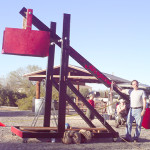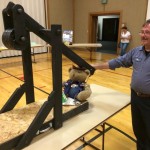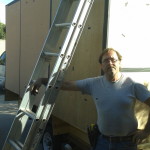Projects
In order for a vision or plan to be taken seriously, there must be demonstrations available that people can touch, and see how they will work on the frontier. Without such demonstration projects, this vision is just an opinion piece.
So, take a look at what we are doing, to SHOW how EarthSeed can work to put people, real people in space for the long term.
- Tiny Home Mobile Technology Demonstrator – This is a full home. It has a desk, bed, microwave, hot plate, mini-refridgerator, its own power supply, and backup. It is a 4′ x 8′ trailer frame supporting a 6′ x 12′ living space.
- Aquaponics Laboratory – Built into the floor of the Tiny Home is a small fish pond, designed to house as many as 10 fully grown tilapia at any one time. The water from the pond is pumped up to a manifold in the ceiling of the slideout containing the vertial garden.
- Interior Vertical Vegetable Garden – Water flows by gravity feeding the plants all the way to the bottom, where it then returns to the fish pond. Lighting in the ceiling provides nearly 18 hours of continuous, yet varied light to feed the plants as they soak up the water provided from the fish pond.
- Mycellium-Ceramic Drinking Water Filtration – a small amount of water from the plant return is pumped to a tower containing a mycellium lattice at the top, and a ceramic filter at the bottom. These provide two-stage drinking water filtration and storage. The filter is designed as a constant flow device. That is to say, water always flows through. When not dispensing for drinking, the overflow is returned to the fish pond to start the cycle over, providing a refreshing topping off just as would happen in nature.
- Two stage Composting Toilet – This toilet also serves as the biomass-waste catch. Black Soldier Fly larvae reside in the upper layer, processing all the high moisture material dropped in. Their leavings work their way down, and are then consumed by the Red Wiggler worms whose castings provide the foundation for compost to be placed on root plants.
- Compact Rain Catchment – Unlike most mobile transports, the Tiny Home is designed to catch as much water as possible that falls on its exterior. Channels are placed around its perimeter to catch the flowing/dripping water, and channel it to the under-floor storage system. From there, this fresh water is pumped into the drinking water tower-filter. The floor storage system has an overflow system similar to a car’s cooling system, in that when it is at capacity, excess rainwater is vented automatically under the trailer.
- Compact, Solar Driven, Closed Cycle Steam powered Electric Generator – A wide satellite dish provides the reflective surface to a horizontal tubular boiler, that in turn provides steam to a modified 1200 watt gas generator. Exhaust steam from the cylinder head is released into a condensing coil, only to be pumped back up to the boiler.
- Deep-Cycle Battery pack. The target is for these deep-cycle batteries to be able to provide 36 hours of continuous power for the Tiny Home. The solar generator, on sunny days, or the backup gas generator serves as the primary and secondary charging systems.
 Black Scorpion 16 ft arm Modular Trebuchet – Our first construction project was designed as a publicity tool. The Trebuchet is constructed to have a maximum counterweight of 700 pounds, though we have never placed more than 300 lbs in the box. Our unit can hurl an 8 lb projectile approximately 135 feet (41 meters), and a 5 lb projectile 150 feet (45 meters). While respectable, it is no champion. The goals were small storage footprint, ease of transport, one-man setup/takedown, and the ability to demonstrate the seige weapon effectively. Over the last two years, we have achieved all of these goals.
Black Scorpion 16 ft arm Modular Trebuchet – Our first construction project was designed as a publicity tool. The Trebuchet is constructed to have a maximum counterweight of 700 pounds, though we have never placed more than 300 lbs in the box. Our unit can hurl an 8 lb projectile approximately 135 feet (41 meters), and a 5 lb projectile 150 feet (45 meters). While respectable, it is no champion. The goals were small storage footprint, ease of transport, one-man setup/takedown, and the ability to demonstrate the seige weapon effectively. Over the last two years, we have achieved all of these goals. Baby Scorpion 4 ft arm Modular Trebuchet – The baby was constructed as a kit to be portable, easy to set up and take down, for use as a teaching aid. The prototype kit was quite the darling at a recent Boy Scout meeting where it was unveiled for the first time. The cool thing about the trebuchet, is that it is a physics laboratory, demonstrating relationships between mass, gravity, trajectory, not to mention structural design, and fluid motion.
Baby Scorpion 4 ft arm Modular Trebuchet – The baby was constructed as a kit to be portable, easy to set up and take down, for use as a teaching aid. The prototype kit was quite the darling at a recent Boy Scout meeting where it was unveiled for the first time. The cool thing about the trebuchet, is that it is a physics laboratory, demonstrating relationships between mass, gravity, trajectory, not to mention structural design, and fluid motion.
